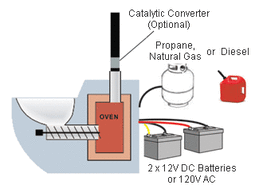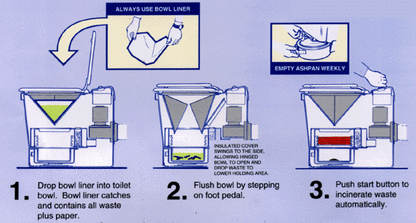The Incinerating Toilet
An incinerating toilet is a toilet that burns excrement instead of flushing it away with water.
There are 2 types of incinerating toilets:
- Gas Powered
- Electric Powered
Gas Powered

An example - The ECOJOHN SR Series
After the toilet has been used, all waste, liquid waste, and paper gets moved into the burn chamber by an auger. Automatically, a built in burner ignites and starts the incineration process. The incineration process continues until all of the waste material is gone. This process takes about 5-10 minutes for a short cycle (liquid waste) and 20-30 minutes for a long cycle (waste).
After the toilet has been used, all waste, liquid waste, and paper gets moved into the burn chamber by an auger. Automatically, a built in burner ignites and starts the incineration process. The incineration process continues until all of the waste material is gone. This process takes about 5-10 minutes for a short cycle (liquid waste) and 20-30 minutes for a long cycle (waste).
Electric Powered

An example - The INCINOLET
INCINOLET uses electric heat to reduce human waste (urine, solids, paper) to a small amount of clean ash, which is dumped periodically into the garbage. INCINOLET remains clean because waste never touches the bowl surface. A bowl liner, dropped into the bowl prior to use, captures the waste, then both liner and its content drop into the incinerator chamber when the foot pedal is pushed.
INCINOLET uses electric heat to reduce human waste (urine, solids, paper) to a small amount of clean ash, which is dumped periodically into the garbage. INCINOLET remains clean because waste never touches the bowl surface. A bowl liner, dropped into the bowl prior to use, captures the waste, then both liner and its content drop into the incinerator chamber when the foot pedal is pushed.
.
Advantages:
Disadvantages:
Applications:
- Uses no water
- Produces a fine sterile ash that can be safely disposed of
- Portable, simple to install, and easy to use. Can work in freezing conditions and remote areas
- Relatively odorless, compared to common storage outhouses and portable toilets
Disadvantages:
- Incineration destroys nutrients in waste, making ash less valuable for replenishing soil
- Requires energy—results in higher energy costs for users
- Not entirely pollution free, electric energy use leaves a carbon footprint, and gas energy use releases some air pollutants
Applications:
- Rural areas where sewage systems are not practical for financial or geographic reasons.
- Job sites where permanent toilets are not available
- Marine vessels operating in areas that waste discharge is prohibited
- Areas where water is scarce
- Areas where water contamination is an issue
